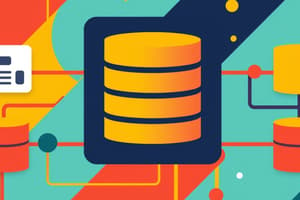Podcast
Questions and Answers
What is data?
What is data?
Data is a raw and unorganized fact that requires processing to make it meaningful.
Define information.
Define information.
Information is refined or processed data that has been transformed into a meaningful and useful form for specific users.
Which of the following is a type of database?
Which of the following is a type of database?
- Phone Book
- Shopping List
- Your 5 Best Friends
- All of the above (correct)
A database is a collection of unorganized data.
A database is a collection of unorganized data.
What is a file system?
What is a file system?
What are the components of a Database System?
What are the components of a Database System?
What is a table in a database?
What is a table in a database?
What is a field in a database table?
What is a field in a database table?
What is a record in a database?
What is a record in a database?
Flashcards are hidden until you start studying
Study Notes
Data and Information
- Data refers to raw, unorganized facts that require processing to become meaningful.
- Types of data include facts, observations, numbers, characters, symbols, and images.
- Information is processed data transformed into a meaningful format that serves specific user needs.
Database
- A database is a structured collection of related data for efficient storage, retrieval, and management.
- Examples of databases include phone books, shopping lists, to-do lists, and user bases on social media.
- Databases can be simple, like a single file, or complex with multiple interconnected tables.
File System
- A file system manages how data is stored, accessed, and managed on storage disks.
- Common drawbacks include:
- Data redundancy and inconsistency.
- Difficulty accessing data.
- Data isolation issues.
- Integrity problems and atomicity of updates.
- Security concerns and challenges with concurrent access by multiple users.
Database System
- A database system consists of a database (DB), database Management System (DBMS), and application programs.
- It serves as a computerized record-keeping system and acts as a repository for computerized data files.
- Main components include:
- Data: The actual information stored.
- Hardware: Physical devices used for storage and processing.
- Software: The applications that manage and manipulate data.
- User: Individuals who interact with the database system.
Tables
- Data is organized in databases as tables, which are collections of related data entries.
- A table is structured with columns (fields) and rows (records).
Fields
- Each table is divided into fields, which are specific columns that hold particular information about each record.
- For example, a CUSTOMERS table may include fields like ID, NAME, AGE, ADDRESS, and SALARY.
Records or Rows
- A record, also known as a row of data, represents an individual entry within a table.
- Each row in a table contains specific data according to the defined fields, forming a complete record.
Studying That Suits You
Use AI to generate personalized quizzes and flashcards to suit your learning preferences.




